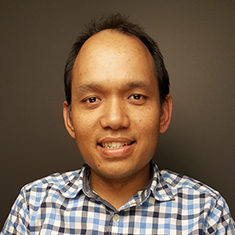Armin K. Silaen, Ph.D.
Associate Director for Operations for CIVS | Associate Professor of Mechanical Engineering (by courtesy)
Research Associate Professor - Purdue University Northwest, Steel Manufacturing Simulation and Visualization Consortium

Introduction
Armin Silaen is a Research Associate Professor with the Center for Innovation through Visualization and Simulation (CIVS). He received a Ph.D. degree in Mechanical Engineering from the University of New Orleans in 2010. His research focuses on simulation of multiphase reacting flows, with specific work in the fields of iron and steelmaking. He currently leads research in the continuous casting modeling, among related steelmaking research at the Steel Manufacturing Simulation and Visualization Consortium (SMSVC). His applied research is aimed at developing methods and technologies for improving energy efficiency, reducing waste, minimizing carbon emissions, and improving process stability.
Select Publications
C. Uzor, J. Rosser, A. K. Silaen, K. Tian , J. Maiolo, K. Johnson, L. Fabina and C. Zhou, “Heat Transfer and Flow Dynamics Comparison of Hydrogen vs. Natural Gas as Fuel in an Industrial Reheat Furnace,” Journal of Thermal Science and Engineering Application, (in press).
S. Thapa, M. Wang, A. K. Silaen, M. E. Ferreira, W. Rollings, C. Zhou, “Application of Electromagnetic Braking to Minimize a Surface Wave in a Continuous Caster,” Materials, Vol 16, Iss. 3 (2023)
H. Ma, A. Silaen, C. Zhou, “Numerical Development of Heat Transfer Coefficient Correlation for Spray Cooling in Continuous Casting,” Frontiers in Material, Vol. 7, Article 577265, (2020).
T. Okosun, A. K. Silaen, C. Q. Zhou, “Review on Computational Modeling and Visualization of the Ironmaking Blast Furnace at Purdue University Northwest,” Steel Research International, Vol. 90, Iss. 4 (2019).
Why I became an engineer…
I was fascinated by airplanes when I was young and I always enjoyed math and science in school. This eventually led me to pursue an engineering degree.
What engineers can do to make a difference…
We are faced with challenges to create a safer and more sustainable world. Engineers can a make difference by developing and implementing innovative solutions to minimize carbon emissions from the industrial processes, while at the same time improving productivity and energy efficiency.